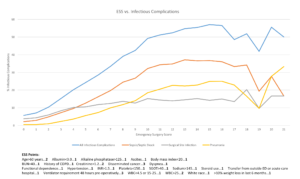The Emergency Surgery Score (ESS) Accurately Predicts the Risk of Postoperative Infection in Emergency General Surgery
Author(s):
Kelsey Han; Jae Lee; Aditya Achanta; Napaporn Kongkaewpaisan; Manasnun Kongwibulwut; Ahmed Eid; Nikolaos Kokoroskos; Suzanne Van Wijck; Ask Nordestgaard; Gabriel Rodriguez; Zhenyi Jia; Jarone Lee; David King; Peter Fagenholz; Noelle Saillant; April Mendoza; Martin Rosenthal; George Velmahos; Haytham Kaafarani
Background:
The Emergency Surgery Score (ESS) was recently created and validated as an accurate and user-friendly postoperative mortality risk calculator specific for Emergency General Surgery (EGS). ESS is calculated by adding integer points for 22 preoperative variables (demographics, co-morbidities, and preoperative laboratory values); increasing scores accurately and gradually predict higher mortality rates. We sought to evaluate whether ESS can predict the occurrence of post-operative infectious complications in EGS patients.
Hypothesis:
In EGS patients, a higher ESS is associated with an increased likelihood of post-operative infectious complications.
Methods:
Using the American College of Surgeons National Surgical Quality Improvement Program (ACS-NSQIP) database from 2007-2015, EGS patients were identified by using the “emergent” ACS-NSQIP variable and a concomitant surgery CPT code for “digestive system”. Patients with missing ESS variables or those who died within 72 hours from surgery were excluded. A composite variable, postoperative infection, was created and defined as the postoperative occurrence of one or more of the following: superficial, deep incisional or organ/space surgical site infection, wound disruption, pneumonia, sepsis, septic shock, or urinary tract infection. ESS was calculated for all included patients, and the correlation between ESS and postoperative infection was examined using c-statistics.
Results:
Out of a total of 4,456,809 patients, 90,412 patients were included. The mean age of the population was 56 years, 51% were female, and 70% were white; 22% developed one or more post-operative infections, most commonly sepsis/septic shock (12.2%), surgical site infection (9%), and pneumonia (5.7%). ESS gradually and consistently predicted infectious complications with 7%, 24%, and 49% of patients with an ESS of 1, 5, and 10 developing postoperative infections, respectively [Figure 1]. The c-statistics for overall postoperative infection, postoperative sepsis/septic shock and pneumonia were 0.73, 0.75 and 0.80, respectively.

Conclusions:
ESS accurately predicts the occurrence of postoperative infectious complications in EGS patients, and could be used for preoperative clinical decision-making as well as quality benchmarking of infection rates in EGS.

